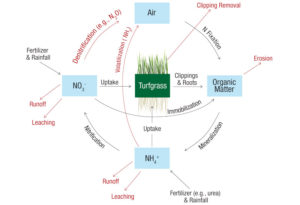Fertilization, irrigation strategies reduce emissions, conserve water
Use of controlled-release fertilizers and improved irrigation techniques may produce better visual turf quality while reducing nitrous oxide emissions.

Figure 1. Simplified conceptual model illustrating the nitrogen cycle. Illustration by Ross Braun
Editor’s note: This research was funded in part by the United States Golf Association.
The goal of a nitrogen fertilizer program should be to optimize plant uptake while minimizing nitrogen losses, such as runoff, leaching and gaseous losses. As stewards of the environment, golf course superintendents should understand how nitrogen moves in the environment and be aware of the importance of preventing nitrogen fertilizer from contaminating groundwaters and surface waters through leaching and runoff. They should also be aware of reducing gaseous losses of nitrogen.
No single nitrogen fertilizer program is best for all turf. Nitrogen fertilizer programs will vary by turf species, especially between cool- and warm-season grasses, and among soil conditions (for example, soil type, properties, pH, slope, soil water content and soil temperature) and site conditions (for example, environment, climate and site use). Therefore, an effective nitrogen fertilizer program incorporates information about the soil and site conditions, the appropriate nitrogen amounts and timing of application, and what happens to the nitrogen fertilizer once it is applied to the turf.
Plants absorb nitrogen as both nitrate (NO3–) and ammonium (NH4+), and preference for either varies by age and type of plant, environment, and other factors. In the turf industry, most of the nitrogen fertilizer is applied as urea, which is quickly converted to ammonium by urease, an enzyme found in soils and on the turf.
Does all the nitrogen fertilizer applied get taken up by the plant? No. Why not? Because at the time of fertilizer application, multiple environmental factors and management practices may influence the nitrogen processes on the turf and in the soil, and these practices may result in the loss of nitrogen through multiple nitrogen pathways in the soil-plant-atmosphere system (Figure 1, above).
Gaseous losses from denitrification
One of these nitrogen pathways is denitrification, the process by which denitrifying bacteria convert nitrate into dinitrogen (N2), nitric oxide (NO) and nitrous oxide (N2O) gases, which are all released into the atmosphere.
Nitrous oxide, an important greenhouse gas associated with global climate change, is reportedly 310 times more effective than carbon dioxide (CO2) at trapping longwave radiation (that is, heat) in the atmosphere, and it is, potentially, the gas that is responsible for the greatest depletion of ozone (6, 10).
From 1990 to 2005, agricultural activities (nitrogen fertilization and soil management) have increased worldwide nitrous oxide emissions by 17% (6, 12). Applications of fertilizer to agricultural land — including turfgrass systems (4, 7, 8) — are responsible for a significant percentage of the nitrous oxide emitted into the atmosphere each year (9).
Denitrification typically occurs under anaerobic conditions — wet soil conditions with an absence or limited amount of free oxygen. Therefore, an increase in soil moisture during or after nitrogen fertilization may significantly amplify nitrous oxide fluxes.
Past research in turfgrass has shown nitrous oxide emissions typically increase after nitrogen fertilization (especially with quick-release fertilizers) that is followed by precipitation or irrigation (1, 4, 7, 8). Turfgrass researchers measuring nitrous oxide emissions have concentrated mainly on quick-release fertilizers, and few investigations have looked at the influence of controlled-release (slow-release) fertilizers on nitrous oxide emissions.
The use of controlled-release fertilizers, such as polymer-coated urea (PCU) or sulfur-coated urea (SCU), may reduce emissions by decreasing the amount of nitrogen in the soil that is available for denitrification (11). Therefore, in order to develop management practices that have the potential to reduce nitrous oxide emissions in turfgrass, further research is required on the effects of the amount of irrigation and the different forms of nitrogen fertilizer on nitrous oxide emissions (2).
We hypothesized that employing smarter turfgrass management practices such as combining the use of controlled-release fertilizers with improved irrigation techniques (for example, deficit irrigation) would reduce N2O emissions.
